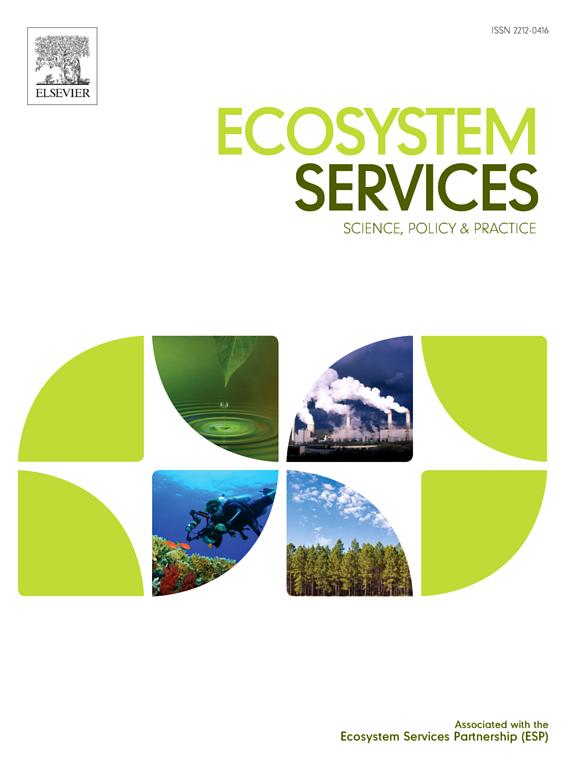Analysis of spatiotemporal changes in ecosystem services distribution in the southern part of the Atlantic Forest in Brazil
IF 6.6
2区 环境科学与生态学
Q1 ECOLOGY
引用次数: 0
Abstract
Understanding ecosystem services (ES) is crucial for policies aimed at ensuring biodiversity conservation, natural resources, and livelihoods for humanity. In the state of Paraná, southern Brazil, the overlap between the Atlantic Forest domain and extensive agricultural areas suggests possible trade-offs between natural ecosystems and commodity production. This study aimed to evaluate the spatial distribution, synergies, trade-offs, and the net change among multiple ES at the state level. We selected nine indicators of four categories of ES: regulating services (carbon storage, soil conservation, and water yield), supporting services (plant biodiversity), provisioning services (cassava, orange, and soybean production), and cultural services (aesthetics and archaeological patrimony). Results indicated contrasting dynamics over the past decades. While provisioning services, especially soybean production, increased substantially, regulating services declined, revealing clear trade-offs in land-use priorities. Synergies were observed among regulating, cultural, and supporting services, especially in areas with preserved vegetation. Conversely, trade-offs emerged between provisioning and regulating services, notably between the expansion of soybeans and carbon storage. Municipalities exhibited variations in ES production, and four distinct groups were identified based on the similarity of indicator values among municipalities. These regional disparities, influenced by land use and conservation practices, resulted in the formation of landscape clusters (bundles): Non-fragmented Forest Landscape, Fragmented Forest Landscape, Homogeneous Agricultural Landscape, and Mixed Agricultural Landscape. Different synergies and trade-offs among ES indicators highlighted the ecological and social dynamics over time and the land use strategies promoted, which reduced regulating services in favor of commodity production. These findings demonstrate the spatial variability of ES and highlight how land-use strategies can intensify trade-offs while weakening ecological multifunctionality. The study highlights the importance of integrated land management in balancing provisioning demands with the maintenance of ecological functions and promoting the diversification of ecosystem services provision.
巴西大西洋森林南部生态系统服务功能的时空变化分析
了解生态系统服务对于确保生物多样性保护、自然资源和人类生计的政策至关重要。在巴西南部的帕拉纳州,大西洋森林域和广泛的农业区之间的重叠表明,自然生态系统和商品生产之间可能存在权衡。本研究旨在评估多个ES在州一级的空间分布、协同效应、权衡和净变化。我们选择了4类ES的9个指标:调节服务(碳储量、土壤保持和水量)、支持服务(植物生物多样性)、供给服务(木薯、橘子和大豆生产)和文化服务(美学和考古遗产)。结果表明,在过去的几十年里,这一趋势形成了鲜明的对比。虽然供应服务(尤其是大豆生产)大幅增加,但调节服务却下降了,这表明土地使用优先次序方面存在明显的权衡。在调节、文化和支持服务之间观察到协同效应,特别是在保留植被的地区。相反,在提供和调节服务之间出现了权衡,特别是在大豆扩张和碳储存之间。各城市在ES生产方面表现出差异,根据各城市之间指标值的相似性,确定了四个不同的群体。这些区域差异受土地利用和保护措施的影响,形成了景观集群(束):非破碎化森林景观、破碎化森林景观、同质农业景观和混合农业景观。生态环境指标之间的不同协同作用和权衡突出了随着时间的推移生态和社会动态,促进了土地利用战略,减少了有利于商品生产的调节服务。这些发现表明了生态系统的空间变异性,并强调了土地利用策略如何在削弱生态多功能性的同时加强权衡。该研究强调了综合土地管理在平衡供应需求与维持生态功能和促进生态系统服务提供多样化方面的重要性。
本文章由计算机程序翻译,如有差异,请以英文原文为准。
求助全文
约1分钟内获得全文
求助全文
来源期刊

Ecosystem Services
ECOLOGYENVIRONMENTAL SCIENCES&-ENVIRONMENTAL SCIENCES
CiteScore
14.90
自引率
7.90%
发文量
109
期刊介绍:
Ecosystem Services is an international, interdisciplinary journal that is associated with the Ecosystem Services Partnership (ESP). The journal is dedicated to exploring the science, policy, and practice related to ecosystem services, which are the various ways in which ecosystems contribute to human well-being, both directly and indirectly.
Ecosystem Services contributes to the broader goal of ensuring that the benefits of ecosystems are recognized, valued, and sustainably managed for the well-being of current and future generations. The journal serves as a platform for scholars, practitioners, policymakers, and other stakeholders to share their findings and insights, fostering collaboration and innovation in the field of ecosystem services.
 求助内容:
求助内容: 应助结果提醒方式:
应助结果提醒方式:


